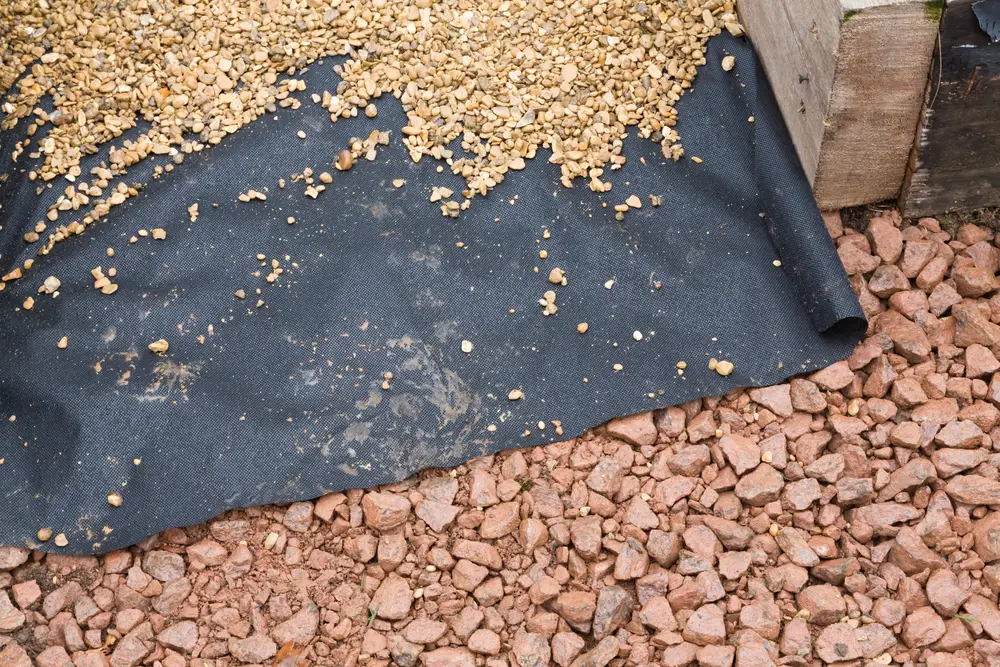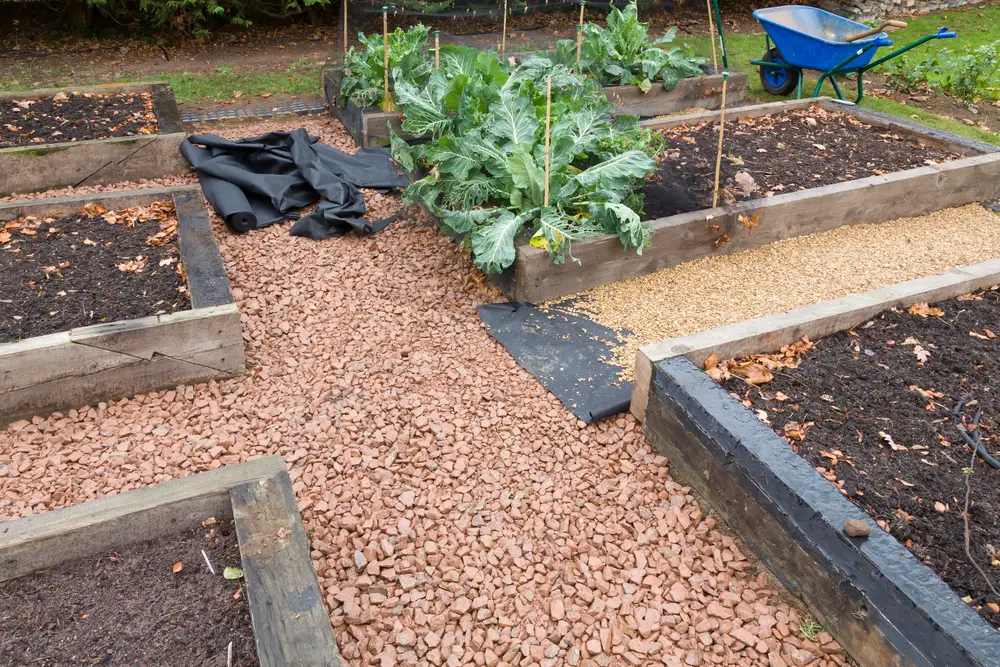Manufacturers market landscape fabric (or weed barrier) as a long-term solution to reduce or prevent weed growth in your garden.
Who wouldn’t want that?
Unfortunately, for those of us who have installed landscape fabric before, we soon come to regret it. It doesn’t perform well long-term, and it usually ends up causing more problems than it solves.
Ultimately, it causes issues such as the following:
- Poor plant growth
- Hindering beneficial organisms in the soil
- Looking ugly if you don’t cover it with some sort of mulch
- Only reducing weed growth for about a year
Removing or replacing it is backbreaking, especially if it’s been buried for a few years under layers of mulch and soil.
In other words, we don’t recommend it.
However, landscape fabric does have some limited uses.
When And How To Use Landscape Fabric

Uses for landscape fabric include the following:
- Short-term installations, such as with annual plantings
- Putting it underneath pathways
- Putting it underneath permanent decorative features
In other words, landscape fabric is at its most effective and least frustrating when you plan to use it for a short time, ideally in a place you plan to have no plants.
Let’s dive deeper into each, starting with annual plantings.
Annual Plantings
In this case, we’re talking about planting something such as a vegetable garden for one season.
Landscape fabric made from woven plastics is better for this purpose than the polymer-spun ones that feel like felt. The latter are lighter weight, tear more easily, and don’t last well.
Various landscape fabric varieties – sometimes called “paper mulch” – are made from wood pulp. You use these for one growing season, then dig them into the soil to break down or dispose of them through local composting programs.
Also, because landscape fabric is black, it absorbs and traps heat from the sun, warming up the soil underneath it. This means the soil warms up sooner in the spring, giving you a head start on the growing season. Using landscape fabric for young transplants rather than direct seeding in the soil is best.
Steps
To use landscape fabric for growing annuals like vegetables, prepare your soil with any necessary amendments, such as compost.
You can use the fabric just to cover the planted rows and have grass or wood chips pathways in between, or cover the whole area (planting rows and pathways) with the fabric.
If using it to cover the whole area, overlap the edges by several inches so there are no bare patches of soil or cracks where weeds could grow. You can anchor the fabric with stones or bricks every few feet, pieces of 2×4 wood, or anything heavy. You can also use landscape staples (AKA garden staples).
If covering the whole area, decide where your planted rows and pathways will be. Mark the planting rows and walk only on the pathways so you don’t pack down the soil under the fabric where the plants will grow.
To plant young transplants, cut an X in the fabric, pull back the four corners, dig a hole, and plant as usual. Water the transplant and fold the fabric corners back around its base.
Drip irrigation or a soaker hose laid down under the fabric is the most efficient way to water when using landscape fabric. This minimizes moisture loss through evaporation before the water can soak through the fabric and into the soil.
You can carefully roll the fabric off the beds at the end of the growing season to use it again next year. Removing fabric this way prevents the soil from getting too packed and exposes it to the air, keeping the soil healthy.
Pathways
Operators of commercial greenhouses and plant nurseries use woven plastic landscape fabric as flooring. This is because it’s durable and can be swept clean.
You can do something similar with pathways.
Using landscape fabric underneath pathways like this (such as between raised garden beds) prevents you from having to mow grass.
Your best time to install it is when you’re constructing the raised beds with the garden bed edges overlapping the fabric edges by a few inches. This removes any gaps for weeds to grow.
Keep in mind you shouldn’t cover your landscape fabric. You may not like the look of it being exposed like this, but it’s the most efficient way to use it.
In short, leave the fabric bare and sweep it clean occasionally, or don’t use it at all. If not using it, use a thick layer (about six inches) of wood chips for your pathways instead.
Decorative Landscape Features
You can also use landscape fabric where no plants are or will ever grow. This includes areas for dry riverbed features covered with river rocks and stones. The fabric prevents the stones from sinking into the soil over time.
Be aware, however, that dust and soil particles will collect amongst the stones on top of the fabric over time. Eventually, this creates the perfect growing medium for weed seeds blown in on the wind. These weeds can root into the fabric and be hard to pull. Landscape fabric won’t eliminate the need to pull weeds in the long term.
When To Replace Landscape Fabric
Landscape fabric used as pathways not covered with mulch will be exposed to sunlight, which can break down the plastic fabric after several years. To extend the life of your pathways, use the thicker fabric made of woven plastic labeled as having UV protection.
Landscape fabric used for annual plantings should be carefully rolled up at the end of the growing season so you can use it again the following year. You’ll need to replace the fabric eventually when it starts to tear or gets holes in it (other than the planting holes) so that weed seeds in the soil won’t grow through.
If you choose to use landscape fabric covered with mulch in your garden beds (which we don’t recommend), it will be virtually impossible to replace because the mulch builds up over time, burying the fabric. Also, plants sometimes root into the mulch and fabric. Removing the mulch to get at the fabric is so much work, and plant roots may anchor it. You’ll soon find replacing fabric really isn’t an option.

